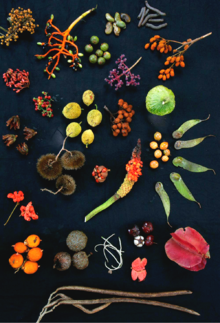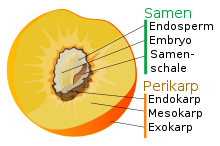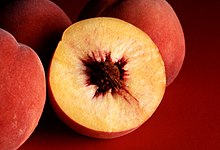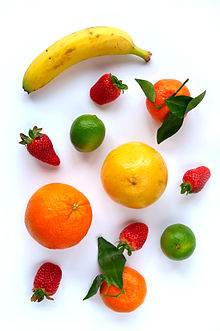Fruit
![]()
This article deals with the plant flower in the state of seed ripeness. For other meanings, see fruit (disambiguation).
![]()
Früchte is a redirect to this article. For the German farmer, merchant and politician, see Jürgen-Christian Früchte.
The fruit (from Latin fructus, in technical terms karp- from Ancient Greek καρπός) of a plant is the totality of the organs that arise from a flower and that enclose the plant seeds until they ripen. Fruits are formed in principle only by those plants which have a closed ovary (angiosperms). In the case of gymnosperms, which include conifers and ginkgo trees, only free seeds are produced.
For example, in addition to the carpel, the following organs may be involved in the formation of a fruit: Axis tissue (for example, the receptacle), perianth, glumes. The fruit is used for dispersal. Depending on whether the seeds are enclosed by the fruit or released when ripe, a distinction is made between closed and open or scattered fruits.
In common parlance, fruit is also understood to include fruit and a clear distinction is not always made between the seeds and the fruit.
Edible parts of plants which, according to different definitions, are classified as vegetables on the one hand and fruits on the other, are known as fruiting vegetables.

Various fruits from the rainforest of Panama
Education
Fruits can be formed aerocarpically (aerial fruiting): they ripen on the above-ground parts of the shoot. A further distinction is made:
- Chamelocarp: diaspores on long axis at ground level
- Euchamelocarp: species with creeping growth
- Pseudochamelocarp: axis becoming flaccid at maturity
Another form is basicarpy: formation of diaspores (fruits) at the base of a plant, near the ground. Fruits can also be formed geocarpic (earth fruit): they ripen underground.
Heterocarpy (different fruiting): the occurrence of differently shaped fruits. Another possibility is amphicarpy (double fruiting): name given to plants which produce differently shaped fruits on the same individual, with fruits formed or ripening simultaneously in the air and in the soil.
The pseudocarpy (false earth fruit): Here the fruit stalk rolls up and pulls the fruit into the ground.
Stem fruiting (cauliflory): Here the fruits develop directly on the stem or on woody branches. A subtype is the branch fruiting (ramifloria).
Structure
A fruit consists of one or more seeds, which are surrounded by an amniotic wall, the pericarp. The pericarp, in turn, is divided into three layers:
- Exocarp - outer layer
- Mesocarp - middle layer
- Endocarp - inner layer
In the peach in the picture on the right, for example, the endocarp forms the hard pit that contains the seed. The mesocarp is fleshy and the exocarp forms the velvety peach skin.
The pericarp is formed from the ovary of the flower during the ripening process of the fruit. For the classification of fruits, it is important to remember that the ovary consists of one or more fused carpels.
The remaining part of the shoot axis and calyx (sepals) is commonly called zilch.

Fruit structure in the genus Prunus

Fruit structure: sliced peach

Banana, strawberries and various citrus fruits
Search within the encyclopedia